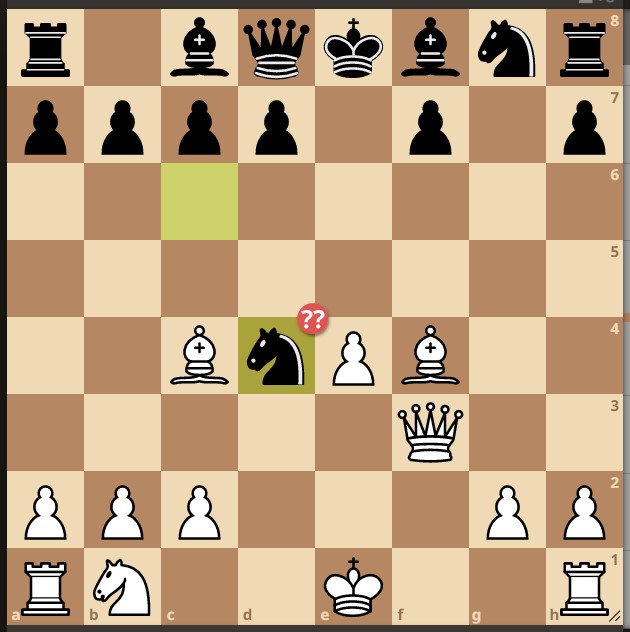Rosentreter gambit Testa variation in the King's gambit
 I am not really a King's gambit man, but a friend of mine loves to play it so I've started looking into it and stumbled upon this very interesting variation which I found very instructive. Basically White is gambitting not only a pawn, but also a piece, all for development and immediate attacking chances. Now, if you thought King's gambit is a romantic era chess opening that has been refuted (no, it has not been, but that's all what people remember from the title of an article written by Robert Fischer 50 years ago) then you will probably will think this continuation is lunacy.
I am not really a King's gambit man, but a friend of mine loves to play it so I've started looking into it and stumbled upon this very interesting variation which I found very instructive. Basically White is gambitting not only a pawn, but also a piece, all for development and immediate attacking chances. Now, if you thought King's gambit is a romantic era chess opening that has been refuted (no, it has not been, but that's all what people remember from the title of an article written by Robert Fischer 50 years ago) then you will probably will think this continuation is lunacy.
Luckily, LiChess makes chess study so simple that even I may sound smart talking about it, so here it is. The position begins from King's gambit accepted - which is the best line for Black according to computer engines, continues with the Rosentreter gambit - allowing Black to chase the important f3 knight away, then White completely abandons the important knight - the so called Testa variation! And then White sacrifices another piece! It's so much fun.
1. e4 e5 2. f4 exf4 3. Nf3 g5 4. d4 { Rosentreter gambit } 4... g4 5. Bxf4 { Testa variation } 5... gxf3 6. Qxf3 { At this point, evaluation is just -1.2, even after sacrificing a piece for a pawn! } 6... Nc6 7. Bc4 Nxd4?? { Black has fallen into the trap. Note that other than the beginning gambit moves and this blunder, all Black moves are Stockfish best moves. } 8. Bxf7+ { Boom! Stockfish evaluation jumps to +5, but getting there takes some time. } 8... Kxf7 9. Qh5+ { No greedy discovered check here as the Queen is under attack. }
Note that there is another similar opening as the gambit I am discussing, also arising from the Rosentreter variation of the King's gambit, where instead of coming up with Bc4, White plays Nc3 - the so called Sørensen Gambit. Similar or same positions may be reached from From's gambit, Vienna gambit, Steinitz gambit, Polerio gambit or Pierce gambit.
Lieutenant Colonel Adolf Rosentreter was a German chess played who lived between 1844 and 1920. He seems to have been a gambit loving chess player, as there are at least two gambits named after him, the most famous being the Giuoco Piano one, which he used to completely destroy a Heinrich Hoefer in 1899, in just 13 moves. Funny enough, in the LiChess player database there are 10 games that end in an identical fashion. I don't know who Testa was, who is possibly the one who should be lauded for this version of the opening.
Anyway, the post is about the gambit in the King's gambit. From my analysis, White can have a lot of fun with this opening. Also, none of the main lines (played the most in LiChess for various ratings) are actually any good, in the sense that the few people who employ the gambit don't know how to implement it best and their opponents usually blunder almost immediately. "Masters" don't use it or at least don't fall into the trap, so keep in mind this is something to use in your own games. So Magnus, don't read this then play it in the world championship or something!
Also, even in the case of Black not falling into the trap, the opening still leaves White fully developed and Black with the burden of demonstrating an advantage. As you can see from the image, the only White piece undeveloped is a knight. Once that happens and the king castles, all pieces are out. Meanwhile, Black has moved only a knight, one that - spoilers alert - will be lost anyway.
Note that I've used Stockfish to play the best moves (other than entering the gambit and accepting the poisoned pawn). For the main lines chapter I've went through the games in the LiChess database. Agreed, there are only a few hundred in total, but that proves how much of a weapon this can become. Hope you enjoy it and as always, I welcome comments.
Without further ado, here is my study for the Rosentreter gambit Testa variation in the King's gambit accepted:
Comments
Be the first to post a comment